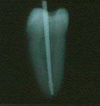Comparing the apical microleakage of lateral condensation and chloroform dip techniques with a new obturation method
- PMID: 22132011
- PMCID: PMC3177377
Comparing the apical microleakage of lateral condensation and chloroform dip techniques with a new obturation method
Abstract
Background: The final objective of root canal therapy is to create a hermetic seal along the length of the root canal system. For this purpose, many methods and materials have been introduced. The purpose of this study was to compare the apical microleakage in a new obturation technique (true-tug-back) with two other obturation techniques (lateral condensation and chloroform dip technique).
Methods: In this in vitro study 102 single canal teeth were selected. The crowns were removed, and the canals were prepared using step-back technique. The master apical file was K-file #40. The teeth were divided into 3 experimental groups of 32 teeth. First group were obturated with lateral condensation technique and second group with chloroform dip technique and the third group with true-tug-back technique. Six teeth were used as control group. The teeth were placed in incubator at 100% humidity and 37°c for three days. The roots of the teeth were coated with two layers of nail varnish except for the apical 2 millimeter. Teeth were placed in Methylene blue 2% for one week. The teeth were sectioned vertically and the depth of maximum dye penetration for each tooth was recorded by stereomicroscope. Data were analyzed using ANOVA and Dunkan test.
Results: The mean liner dye penetration differences between lateral condensation group (6.88 ± 4.06 mm) and chloroform dip technique group (7.16 ± 3.37 mm) were not statistically significant (P = 0.719). The differences between true-tug-back group (3.15 ± 0.52 mm) and two other groups were statistically significant (P < 0.001).
Conclusion: The results of this study showed that the true-tug-back technique can improve apical seal. Further studies are needed for this purpose.
Keywords: Chloroform dip technique; Lateral condensation; Microleakage; Obturation.
Figures
Similar articles
-
An In-Vitro Evaluation and Comparison of Apical Sealing Ability of Three Different Obturation Technique - Lateral Condensation, Obtura II, and Thermafil.J Int Oral Health. 2013 Apr;5(2):35-43. J Int Oral Health. 2013. PMID: 24155589 Free PMC article. Review.
-
An in vitro assessment of apical microleakage in root canals obturated with gutta-flow, resilon, thermafil and lateral condensation: A stereomicroscopic study.J Conserv Dent. 2011 Apr;14(2):173-7. doi: 10.4103/0972-0707.82629. J Conserv Dent. 2011. PMID: 21814361 Free PMC article.
-
The long-term sealing ability of an epoxy resin root canal sealer used with five gutta percha obturation techniques.Int Endod J. 2002 Mar;35(3):275-82. doi: 10.1046/j.1365-2591.2002.00481.x. Int Endod J. 2002. PMID: 11985680
-
Evaluation Of Micro Leakage Of Root Canals Filled With Different Obturation Techniques: An In Vitro Study.J Ayub Med Coll Abbottabad. 2018 Jan-Mar;30(1):35-39. J Ayub Med Coll Abbottabad. 2018. PMID: 29504326
-
A comparative study of apical microleakage using the conventional lateral condensation and mechanical lateral condensation techniques.Iran Endod J. 2008 Summer;3(3):79-82. Epub 2008 Jul 10. Iran Endod J. 2008. PMID: 24146675 Free PMC article.
Cited by
-
Quantification of the tug-back by measuring the pulling force and micro computed tomographic evaluation.Restor Dent Endod. 2017 Nov;42(4):273-281. doi: 10.5395/rde.2017.42.4.273. Epub 2017 Sep 4. Restor Dent Endod. 2017. PMID: 29142875 Free PMC article.
-
Influence of Different Types of Root Canal Irrigation Regimen on Resin-based Sealer Penetration and Pushout Bond Strength.Cureus. 2020 Apr 24;12(4):e7807. doi: 10.7759/cureus.7807. Cureus. 2020. PMID: 32467784 Free PMC article.
-
Assessment of dental students' knowledge and performance of master gutta-percha cone selection and fitting during root canal treatment: a pilot study.BMC Med Educ. 2024 Apr 4;24(1):371. doi: 10.1186/s12909-024-05347-9. BMC Med Educ. 2024. PMID: 38575914 Free PMC article.
-
Lack of correlation between microbial penetration method and electro chemical technique for assessment of leakage through the root canal fillings.Contemp Clin Dent. 2014 Jan;5(1):71-4. doi: 10.4103/0976-237X.128670. Contemp Clin Dent. 2014. PMID: 24808699 Free PMC article.
-
Assessment of consistency in the dimension of gutta-percha cones of ProTaper Next and WaveOne with their corresponding number files.Eur J Dent. 2017 Apr-Jun;11(2):201-205. doi: 10.4103/ejd.ejd_167_16. Eur J Dent. 2017. PMID: 28729793 Free PMC article.
References
-
- Farzaneh M, Abitbol S, Friedman S. Treatment outcome in endodontics: the Toronto study.Phases I and II: Orthograde retreatment. J Endod. 2004;30(9):627–33. - PubMed
-
- Vire DE. Failure of endodontically treated teeth: classification and evaluation. J Endod. 1991;17(7):338–42. - PubMed
-
- Hammad M, Qualtrough A, Silikas N. Evaluation of root canal obturation: a three-dimensional in vitro study. J Endod. 2009;35(4):541–4. - PubMed
-
- Tamarut T, Kovacevic M, Glavicic S. Influence of the length of instrumentation and canal obturation on the success of endodontic therapy.A 10-year clinical follow-up. Am J Dent. 2006;19(4):211–6. - PubMed
-
- Schaeffer MA, White RR, Walton RE. Determining the optimal obturation length: a meta-analysis of literature. J Endod. 2005;31(4):271–4. - PubMed
LinkOut - more resources
Full Text Sources


